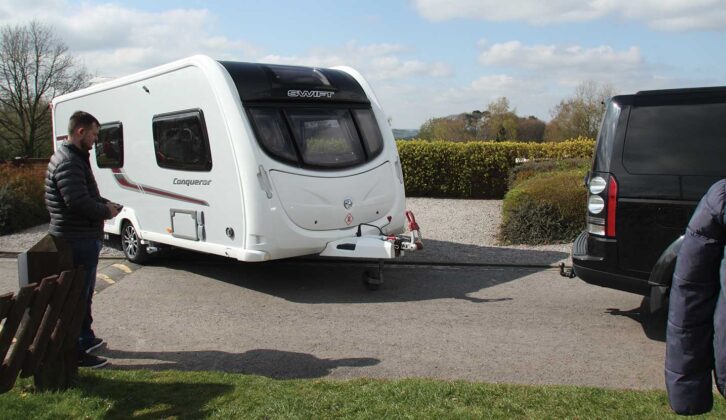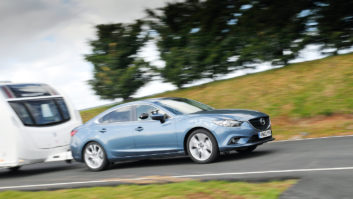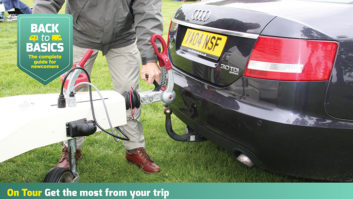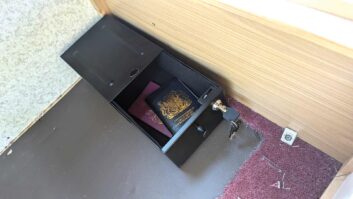Wrangling a caravan onto a campsite pitch or tight driveway space is one of the least enjoyable parts of touring – it can be back or clutch-breaking work!
We’ve all been there – the sweaty palms, smoking clutch and communication ‘issues’ can mean that our holiday gets off to a less-than-harmonious start. And, of course, it all takes place in front of an eagle-eyed cluster of fellow campers!
But, it doesn’t have to be this way. Enter the best caravan motor mover: the gadget that turns two tonnes of stubborn tourer into a pirouetting ballerina, all at the push of a button.
This guide takes you through everything you need to know. What movers are, how they work, what they cost, how they’re fitted, and whether they’re worth the weight they add. By the end, you’ll know if a mover is a caravan essential you cannot be without or not – and, if so, which kind is best.
Caravan motor movers
What is a motor mover?
What does a caravan motor mover do?
How do caravan motor movers work?
How heavy are movers?
Ground clearance
Will a mover work on my steep drive?
How much do movers cost?
Should I buy a new or used caravan mover?
How do I know it’s been fitted properly?
What battery do I need for a caravan mover?
Do caravan movers need maintenance?
How long do caravan motor movers last?
The advantages of modern motor movers
Brands worth knowing about
Are caravan movers worth it?
Caravan motor movers: all you need to know
What is a motor mover?
In the simplest terms, a motor mover is a small electric drive unit that bolts to your caravan’s chassis. When engaged, a roller presses firmly against each tyre and, when powered, rotates the wheel.
One roller per wheel is the standard, which means single-axle vans use two units, while if you own one of the best twin-axle caravans, you will usually need four for the best results.
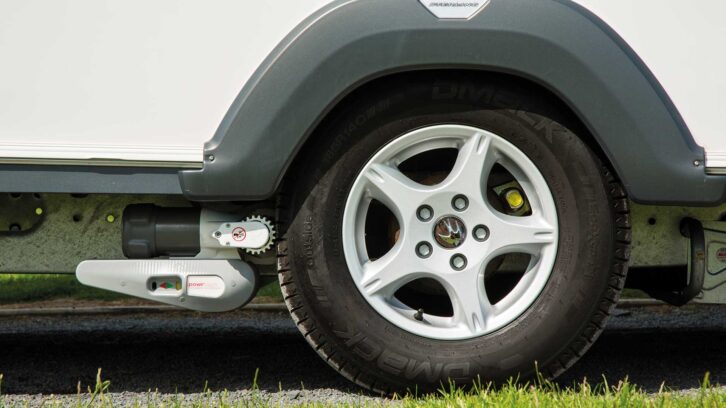
The whole system runs off your leisure battery and is controlled with a remote handset. Press a button and, with a quiet whirring, the caravan moves forward or back. Press a direction button or twist a joystick, and the wheels on one side spin faster than the other, causing the van to turn.
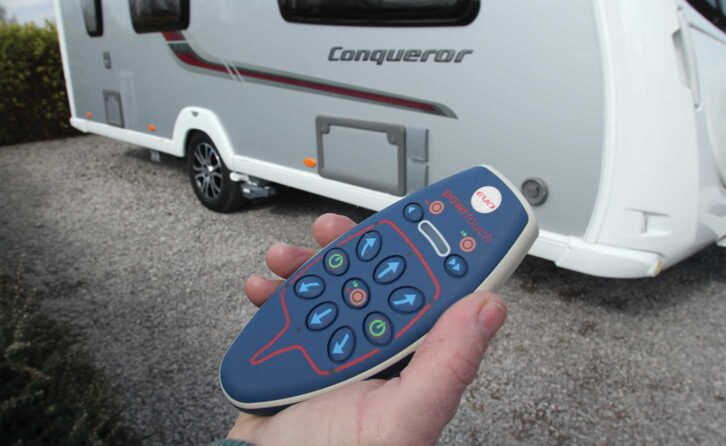
Done right, you can spin a caravan almost within its own footprint – useful, if you’re looking for help with manoeuvres like reversing a caravan.
Motor movers are sensibly and reassuringly slow – about one kilometre an hour – which can feel a bit frustrating, but better safe than sorry.
What does a caravan motor mover do?
A motor mover has three main jobs.
First, manoeuvring on tricky pitches is a doddle. No more squealing clutches, panicked steering or bad-tempered shouting matches in front of your camping neighbours. You simply unhitch and guide the caravan gently into place, saving your nerves and your caravan tow car’s transmission.
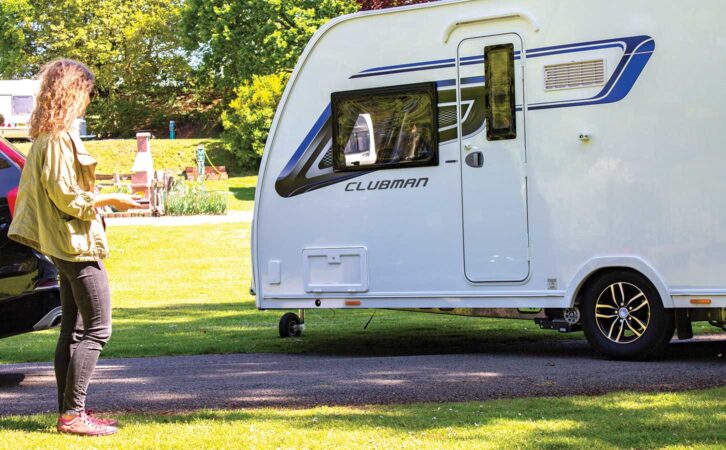
Second, home storage suddenly becomes much simpler. If your drive is steep, narrow, or hemmed-in by walls, a mover gives you fingertip precision to tuck the caravan away without scuffed walls or gouged Tarmac. You can even position the van A-frame-in, facing away from the road for extra caravan security.
Third, it takes the heavy labour out of caravanning. If pushing a van up a drive or onto a pitch is a young person’s game, then a mover extends your touring years by keeping things effortless. Older or less mobile caravanners often find it transforms what’s possible.
There are a couple of bonuses, too. Hitching up a caravan becomes easier. Many modern movers are sensitive enough to nudge the hitch-head perfectly over the towball, without risking a nasty bumper scrape.
Likewise, if you own the best caravan wheel lock, the close control of a motor mover makes them ideal when fitting a single Al-Ko-style wheel lock, where the lock receptor and wheel spokes must align.
How do caravan motor movers work?
A mover consists of a compact motor and gearbox, driving a steel roller. This roller presses into the tread of your caravan’s tyre, creating enough friction to turn the wheel. Gears amplify the motor’s torque, so it can move a caravan weighing up to 2.5 tonnes up a slope as steep as one-in-five.
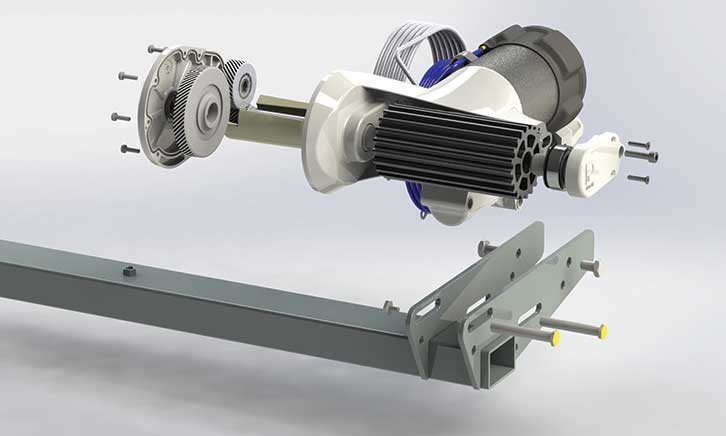
The roller first has to be pressed into the tyre. There are two methods of actuation to engage the rollers.
Manual engagement
You either wind a screw thread or crank a hefty lever over, to press the roller onto the tyre.
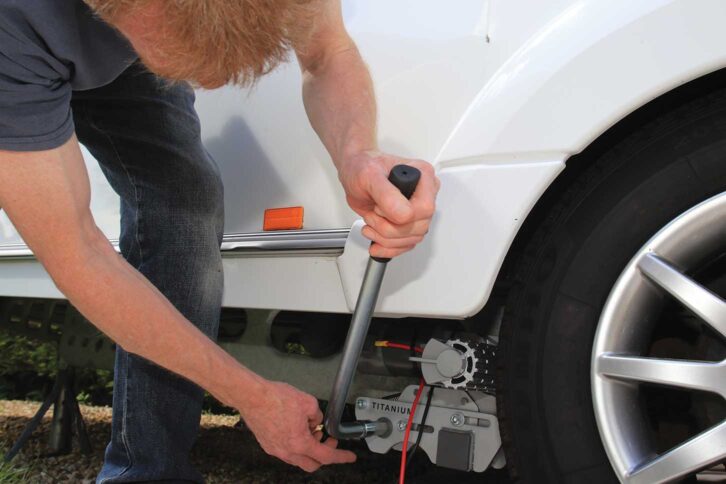
Lever systems are quicker and less tiring than screw threads, but both need a little effort.
Automatic engagement
A motor automatically moves the rollers onto the caravan tyre at the press of a button. These systems cost more, but can be worth it if you store your van tight against a fence or wall, where access is tricky.
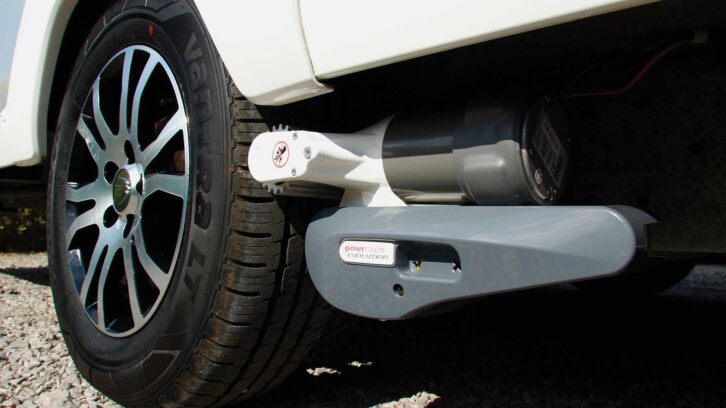
Once engaged, check around the caravan, then stand clear with the remote and guide it wherever it needs to go.
Release the handbrake before moving the tourer, and always reapply it before disengaging the rollers. Never leave the rollers pressed against the tyres for long periods, as that can cause flat spots.
Are they safe?
Yes, if you buy from a reputable brand and have it fitted by a trusted technician like an AWS-approved engineer.
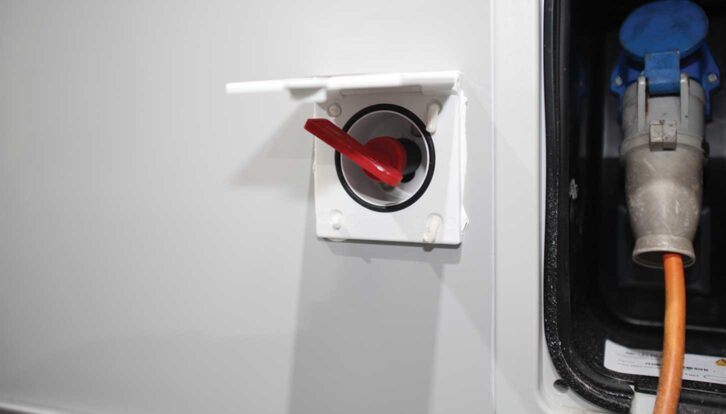
Modern movers have built-in safety systems to stop runaway caravans, accidental commands or overheating. The handset won’t operate if it’s sat ‘on’ in your pocket, and the isolation key cuts all power if you need an emergency stop. Because the top speed is a snail’s pace, you’ve got time to react.
How heavy are movers?
Weight is a drawback. A single-axle mover system usually adds between 24kg and 35kg. A full four-motor twin-axle system can be closer to 70kg. That’s a sizeable chunk of payload, the equivalent of leaving a large awning or half your wine collection at home!
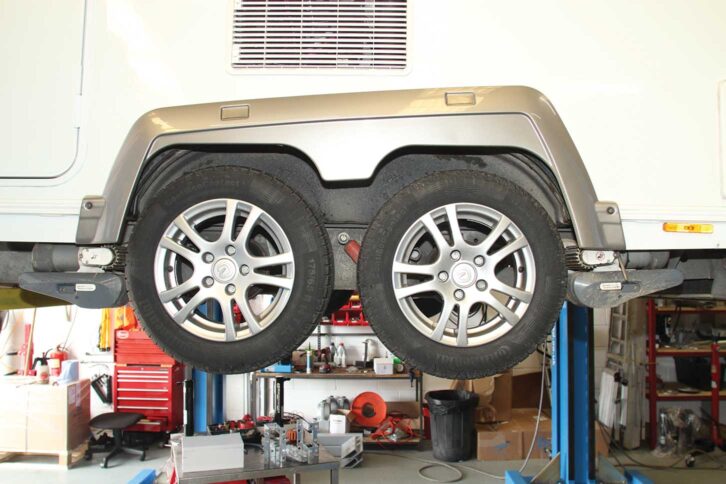
The good news is that technology is bringing the weight down. Lightweight alloys, clever gearing and brushless motors mean many newer movers are far less lardy than their predecessors.
Check out our caravan weights guide if you’re after an overview of the numerous terms you need to be aware of for safe touring.
What about ground clearance?
Ground clearance is a legitimate concern. Movers usually sit under the chassis, which means the lowest point of your van may now be the mover.
Industry guidelines recommend at least 150mm clearance. Anything less risks scrapes on speed bumps or steep ferry ramps.
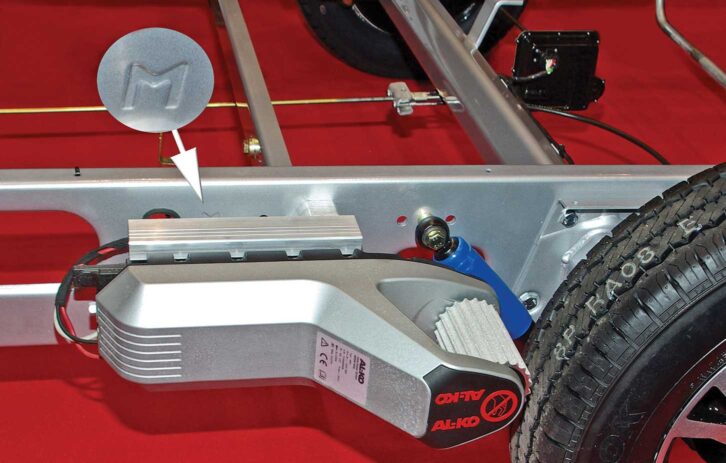
If you have a van with an Al-Ko chassis built after 2010 (and stamped with an M), the flush-fitting Mammut mover mounts neatly without reducing clearance. It’s a clever design, which gives about an extra 6cm of ground clearance over a standard design.
Will a mover work on my steep drive?
Most movers will pull a van up a 20% gradient (one-in-five). Some claim even steeper (the Mammut can pull up 28% slopes), but the results depend on surface grip, caravan weight and battery health. Wet grass and polished block paving are your enemies. On good Tarmac, though, movers can make light work of steep inclines.
How much do movers cost?
Prices vary hugely. At the budget end, a single-axle system starts around £500-£600, plus fitting. For a top-end, automatically engaged, twin-axle system, expect to fork out £2000-£2600.
Installation typically costs another £200-£300 and takes about half a day, though handy DIYers can fit one themselves in under a day.
Warranties are typically five years from a quality manufacturer.
Should I buy a new or used caravan mover?
You can buy secondhand movers, often removed from caravans being broken. Prices range from £250-£600. The risk is wear and tear – corrosion, worn gears and tired electronics. If you buy used, stick to big brands, insist on seeing it working, and check the seller’s reputation.
In reality, most experts advise buying new. Not only do you get a warranty, but you also know it hasn’t been hammered, submerged or abused. That peace of mind is worth the extra.
That said, most caravanners tend to look after their possessions, and motor movers are hardy pieces of kit, so Ebay may be worth a look. I found a Powertouch Evolution Motor Mover single-axle system for sale on the website for £415.
How do I know it’s been fitted properly?
A professional installation should be neat, safe and durable. Look for:
- Cables clipped tidily and protected in trunking where they pass through the chassis member
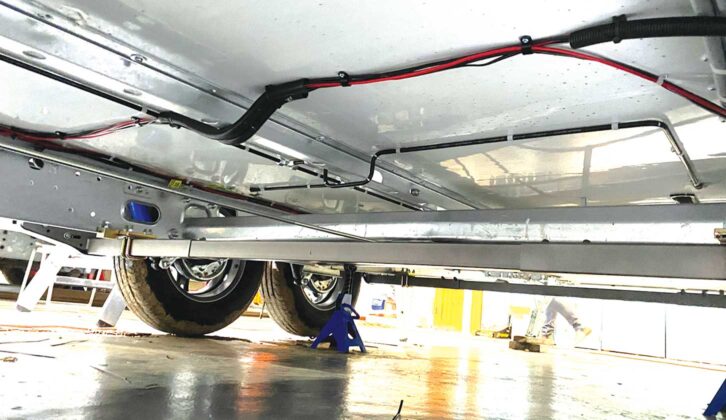
- Minimal holes drilled (ideally using existing holes), all sealed with silicone
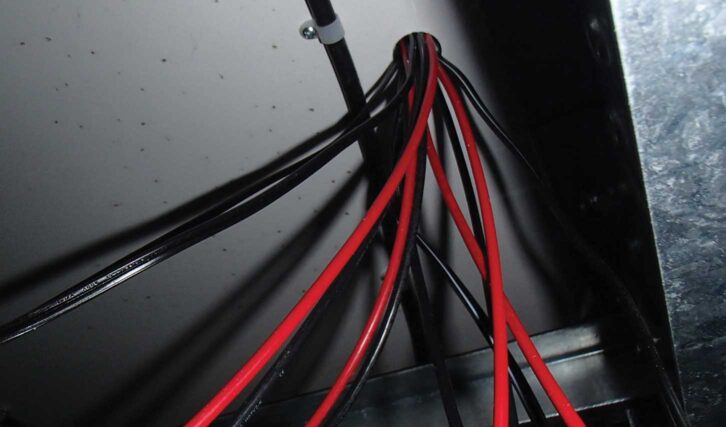
- Control unit mounted out of harm’s way inside a locker or cupboard
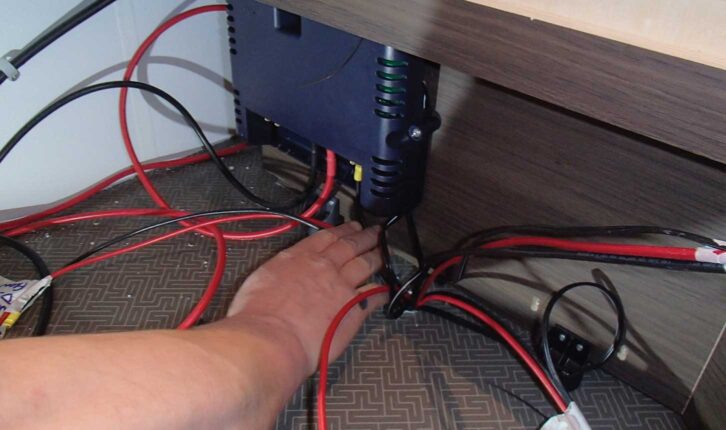
- Cable runs of equal length to balance the power draw. This may mean looping the cable to the nearer unit
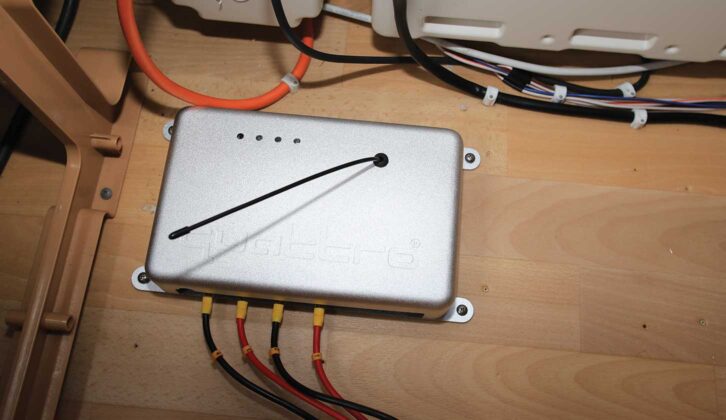
- An isolation switch fitted in or close to the battery box.
If it looks like spaghetti under your van, it probably wasn’t a professional job.
What battery do I need for a caravan mover?
Movers guzzle power, so you will want the best caravan leisure battery for the job. Manufacturers recommend a good-quality, 100-110Ah leisure battery.
It’s important to ask yourself, “what size leisure battery do I need for a caravan?”, though. Smaller batteries may struggle or run out of power, while larger ones may not fit in your battery box.
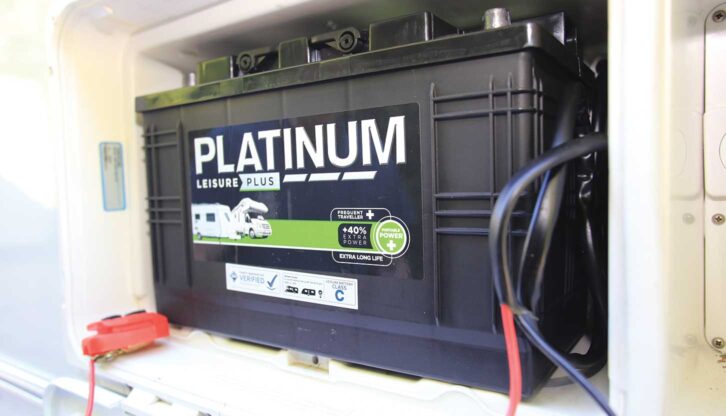
motor mover
Keep your leisure battery well maintained – an intelligent trickle charger is your friend, in this respect.
Beware: Never try to operate the mover by plugging the caravan into the mains when the leisure battery is flat. You’ll fry the control box.
Do caravan movers need maintenance?
Very little. During your annual caravan service, the technician will lubricate the units. If you’re storing the caravan for months, a dab of grease on moving parts before winter is sensible. Give the rollers a short run now and again to prevent seizing.
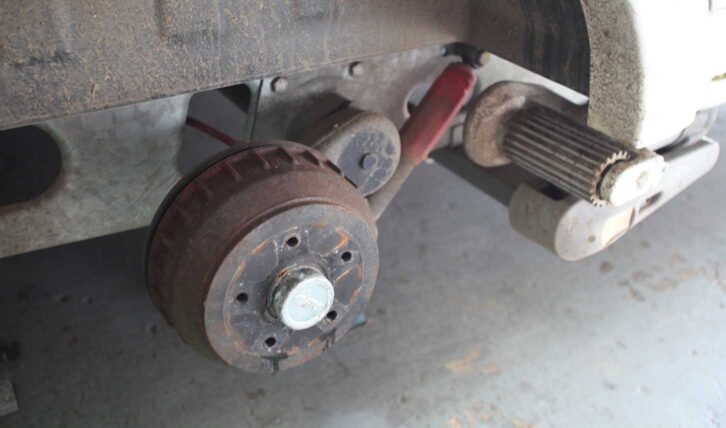
Movers are more likely to suffer from under-use than over-use, so power them up whenever possible
How long do caravan motor movers last?
A well-maintained mover from a trusted brand can last a decade or more, if given basic care and maintenance. That’s plenty of time to make your investment worthwhile.
The advantages of modern motor movers
Today’s movers are far more advanced than the clunky units of old, many with several fancy features on offer.
- Soft-start and stop: Smooth manoeuvring without jolts.
- Brushless motors: More torque, longer life, better efficiency.
- Lightweight alloys: Stronger, slimmer and lighter units.
- Phone app controls: Handy if you misplace the remote controller.
- Upgradeable systems: Add extra motors later if you move to a twin-axle.
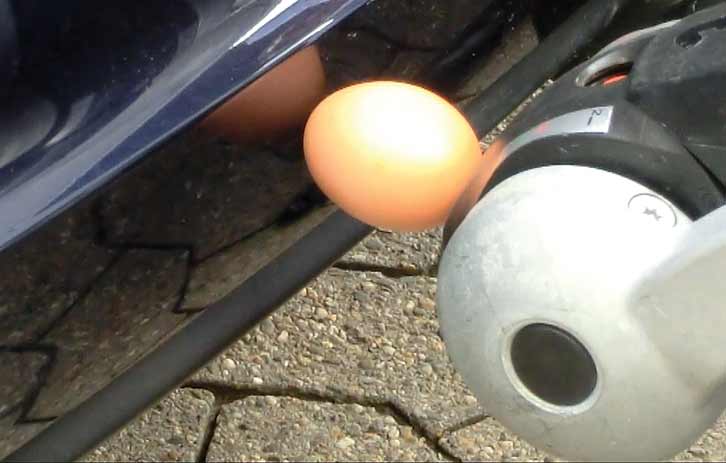
Some of the most sensitive movers can literally trap an egg against a surface without cracking it. Not a daily requirement, but it shows the finesse on offer.
Brands worth knowing about
- Powrtouch: Britain’s best-selling movers. Wide range, with good after-sales support.
- Truma: German precision, brushless motors, superb sensitivity.
- Reich Easydriver: Powerful, stylish, app-controlled in some versions.
- Al-Ko Mammut: Slimline, doesn’t reduce ground clearance.
- E-go (Purple Line): Affordable and lightweight motor movers.
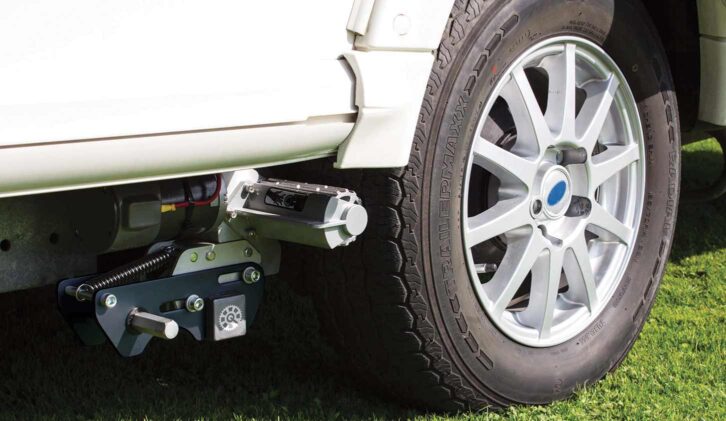
- Emove: Practical, neat and available in manual or auto versions.
- Quattro: Good value, dual-roller technology with joystick control.
- Rhyno: Rugged, British-made, these motor movers are straightforward and tough.
Are caravan movers worth it?
There are pros and cons to consider when you’re deciding whether to get a mover or not.
Pros of a mover
- Effortless manoeuvring on-site or at home
- Save your tow car clutch and your back
- Allows storage in tight or steep places
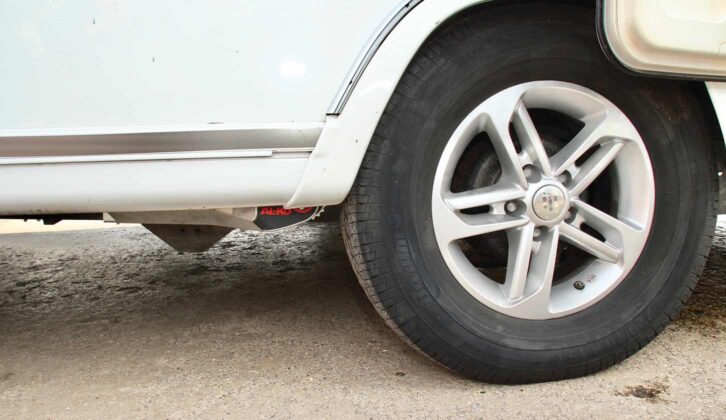
- Makes hitching and wheel-lock fitting a breeze
- Extends caravanning years for older tourers
- Impressively precise, surprisingly fun
Cons of a mover
- Cost – anywhere from £600 to £2600 from single to twin-axle systems
- Weight – 25-70kg of lost payload
- May limit caravan ground clearance, with potential speed-bump scrapes
- Requires a healthy leisure battery to work well
- Adds another system to maintain
The verdict on caravan motor movers
A motor mover isn’t essential, but once you’ve used one, they can feel indispensable. The convenience, the stress relief and the extra possibilities they unlock are hard to ignore.
Yes, they cost quite a lot, and yes, they add weight, but the benefits – longer tow car clutch life, easier home parking and a calmer touring experience – far outweigh the downsides for many.
For some caravanners, a mover is viewed as being one of those luxury caravan accessories. For others, especially those with tight driveways, heavy caravans or those who are less sprightly, it’s a necessity.
Just make sure you choose a reputable brand, get it fitted properly and look after your leisure battery. Do that and you’ll be gliding your caravan into impossible spots for
years to come.
Another useful upgrade to consider to make touring easier is a caravan self-levelling system, an automated system that gets your tourer level when you’re pitched up.
Future Publishing Limited, the publisher of Practical Caravan, provides the information in this article in good faith and makes no representation as to its completeness or accuracy. Individuals carrying out the instructions do so at their own risk and must exercise their independent judgement in determining the appropriateness of the advice to their circumstances and skill level. Individuals should take appropriate safety precautions and be aware of the risk of electrocution when dealing with electrical products. To the fullest extent permitted by law, neither Future nor its employees or agents shall have any liability in connection with the use of this information. You should check that any van warranty will not be affected before proceeding with DIY projects.
If you enjoyed reading this article, why not get the latest news, reviews and features delivered to your door or inbox every month? Take advantage of our brilliant Practical Caravan SUBSCRIBERS’ OFFER and SIGN UP TO OUR NEWSLETTER for regular weekly updates on all things caravan related.
